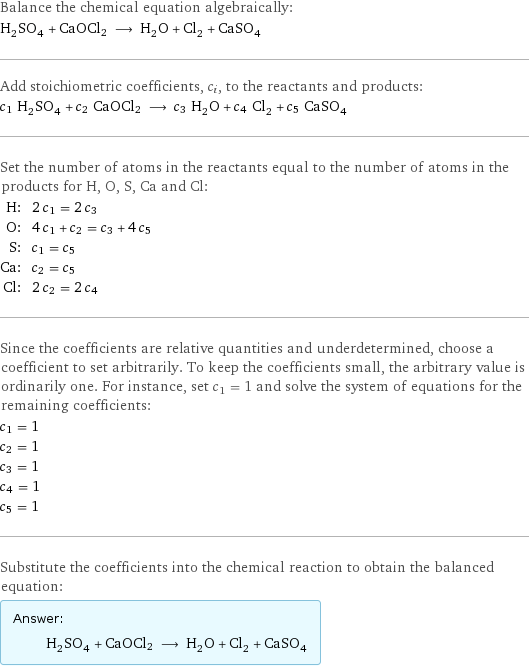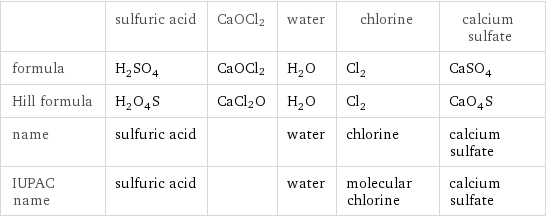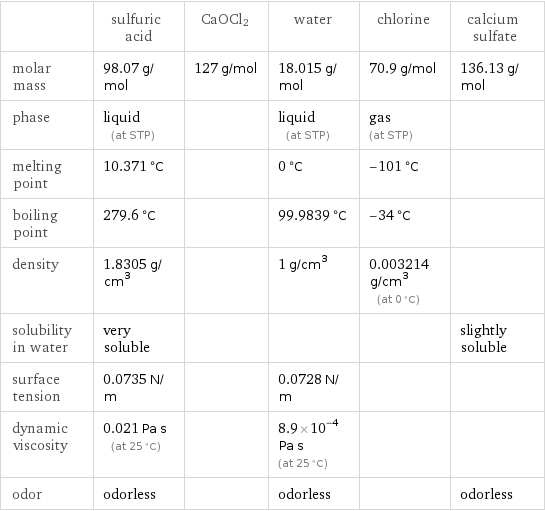Input interpretation

H_2SO_4 sulfuric acid + CaOCl2 ⟶ H_2O water + Cl_2 chlorine + CaSO_4 calcium sulfate
Balanced equation

Balance the chemical equation algebraically: H_2SO_4 + CaOCl2 ⟶ H_2O + Cl_2 + CaSO_4 Add stoichiometric coefficients, c_i, to the reactants and products: c_1 H_2SO_4 + c_2 CaOCl2 ⟶ c_3 H_2O + c_4 Cl_2 + c_5 CaSO_4 Set the number of atoms in the reactants equal to the number of atoms in the products for H, O, S, Ca and Cl: H: | 2 c_1 = 2 c_3 O: | 4 c_1 + c_2 = c_3 + 4 c_5 S: | c_1 = c_5 Ca: | c_2 = c_5 Cl: | 2 c_2 = 2 c_4 Since the coefficients are relative quantities and underdetermined, choose a coefficient to set arbitrarily. To keep the coefficients small, the arbitrary value is ordinarily one. For instance, set c_1 = 1 and solve the system of equations for the remaining coefficients: c_1 = 1 c_2 = 1 c_3 = 1 c_4 = 1 c_5 = 1 Substitute the coefficients into the chemical reaction to obtain the balanced equation: Answer: | | H_2SO_4 + CaOCl2 ⟶ H_2O + Cl_2 + CaSO_4
Structures

+ CaOCl2 ⟶ + +
Names

sulfuric acid + CaOCl2 ⟶ water + chlorine + calcium sulfate
Equilibrium constant
![Construct the equilibrium constant, K, expression for: H_2SO_4 + CaOCl2 ⟶ H_2O + Cl_2 + CaSO_4 Plan: • Balance the chemical equation. • Determine the stoichiometric numbers. • Assemble the activity expression for each chemical species. • Use the activity expressions to build the equilibrium constant expression. Write the balanced chemical equation: H_2SO_4 + CaOCl2 ⟶ H_2O + Cl_2 + CaSO_4 Assign stoichiometric numbers, ν_i, using the stoichiometric coefficients, c_i, from the balanced chemical equation in the following manner: ν_i = -c_i for reactants and ν_i = c_i for products: chemical species | c_i | ν_i H_2SO_4 | 1 | -1 CaOCl2 | 1 | -1 H_2O | 1 | 1 Cl_2 | 1 | 1 CaSO_4 | 1 | 1 Assemble the activity expressions accounting for the state of matter and ν_i: chemical species | c_i | ν_i | activity expression H_2SO_4 | 1 | -1 | ([H2SO4])^(-1) CaOCl2 | 1 | -1 | ([CaOCl2])^(-1) H_2O | 1 | 1 | [H2O] Cl_2 | 1 | 1 | [Cl2] CaSO_4 | 1 | 1 | [CaSO4] The equilibrium constant symbol in the concentration basis is: K_c Mulitply the activity expressions to arrive at the K_c expression: Answer: | | K_c = ([H2SO4])^(-1) ([CaOCl2])^(-1) [H2O] [Cl2] [CaSO4] = ([H2O] [Cl2] [CaSO4])/([H2SO4] [CaOCl2])](../image_source/73e53a3c90e0cda48a153cd232adbc23.png)
Construct the equilibrium constant, K, expression for: H_2SO_4 + CaOCl2 ⟶ H_2O + Cl_2 + CaSO_4 Plan: • Balance the chemical equation. • Determine the stoichiometric numbers. • Assemble the activity expression for each chemical species. • Use the activity expressions to build the equilibrium constant expression. Write the balanced chemical equation: H_2SO_4 + CaOCl2 ⟶ H_2O + Cl_2 + CaSO_4 Assign stoichiometric numbers, ν_i, using the stoichiometric coefficients, c_i, from the balanced chemical equation in the following manner: ν_i = -c_i for reactants and ν_i = c_i for products: chemical species | c_i | ν_i H_2SO_4 | 1 | -1 CaOCl2 | 1 | -1 H_2O | 1 | 1 Cl_2 | 1 | 1 CaSO_4 | 1 | 1 Assemble the activity expressions accounting for the state of matter and ν_i: chemical species | c_i | ν_i | activity expression H_2SO_4 | 1 | -1 | ([H2SO4])^(-1) CaOCl2 | 1 | -1 | ([CaOCl2])^(-1) H_2O | 1 | 1 | [H2O] Cl_2 | 1 | 1 | [Cl2] CaSO_4 | 1 | 1 | [CaSO4] The equilibrium constant symbol in the concentration basis is: K_c Mulitply the activity expressions to arrive at the K_c expression: Answer: | | K_c = ([H2SO4])^(-1) ([CaOCl2])^(-1) [H2O] [Cl2] [CaSO4] = ([H2O] [Cl2] [CaSO4])/([H2SO4] [CaOCl2])
Rate of reaction
![Construct the rate of reaction expression for: H_2SO_4 + CaOCl2 ⟶ H_2O + Cl_2 + CaSO_4 Plan: • Balance the chemical equation. • Determine the stoichiometric numbers. • Assemble the rate term for each chemical species. • Write the rate of reaction expression. Write the balanced chemical equation: H_2SO_4 + CaOCl2 ⟶ H_2O + Cl_2 + CaSO_4 Assign stoichiometric numbers, ν_i, using the stoichiometric coefficients, c_i, from the balanced chemical equation in the following manner: ν_i = -c_i for reactants and ν_i = c_i for products: chemical species | c_i | ν_i H_2SO_4 | 1 | -1 CaOCl2 | 1 | -1 H_2O | 1 | 1 Cl_2 | 1 | 1 CaSO_4 | 1 | 1 The rate term for each chemical species, B_i, is 1/ν_i(Δ[B_i])/(Δt) where [B_i] is the amount concentration and t is time: chemical species | c_i | ν_i | rate term H_2SO_4 | 1 | -1 | -(Δ[H2SO4])/(Δt) CaOCl2 | 1 | -1 | -(Δ[CaOCl2])/(Δt) H_2O | 1 | 1 | (Δ[H2O])/(Δt) Cl_2 | 1 | 1 | (Δ[Cl2])/(Δt) CaSO_4 | 1 | 1 | (Δ[CaSO4])/(Δt) (for infinitesimal rate of change, replace Δ with d) Set the rate terms equal to each other to arrive at the rate expression: Answer: | | rate = -(Δ[H2SO4])/(Δt) = -(Δ[CaOCl2])/(Δt) = (Δ[H2O])/(Δt) = (Δ[Cl2])/(Δt) = (Δ[CaSO4])/(Δt) (assuming constant volume and no accumulation of intermediates or side products)](../image_source/723b4355c465ae377a226ed045c72746.png)
Construct the rate of reaction expression for: H_2SO_4 + CaOCl2 ⟶ H_2O + Cl_2 + CaSO_4 Plan: • Balance the chemical equation. • Determine the stoichiometric numbers. • Assemble the rate term for each chemical species. • Write the rate of reaction expression. Write the balanced chemical equation: H_2SO_4 + CaOCl2 ⟶ H_2O + Cl_2 + CaSO_4 Assign stoichiometric numbers, ν_i, using the stoichiometric coefficients, c_i, from the balanced chemical equation in the following manner: ν_i = -c_i for reactants and ν_i = c_i for products: chemical species | c_i | ν_i H_2SO_4 | 1 | -1 CaOCl2 | 1 | -1 H_2O | 1 | 1 Cl_2 | 1 | 1 CaSO_4 | 1 | 1 The rate term for each chemical species, B_i, is 1/ν_i(Δ[B_i])/(Δt) where [B_i] is the amount concentration and t is time: chemical species | c_i | ν_i | rate term H_2SO_4 | 1 | -1 | -(Δ[H2SO4])/(Δt) CaOCl2 | 1 | -1 | -(Δ[CaOCl2])/(Δt) H_2O | 1 | 1 | (Δ[H2O])/(Δt) Cl_2 | 1 | 1 | (Δ[Cl2])/(Δt) CaSO_4 | 1 | 1 | (Δ[CaSO4])/(Δt) (for infinitesimal rate of change, replace Δ with d) Set the rate terms equal to each other to arrive at the rate expression: Answer: | | rate = -(Δ[H2SO4])/(Δt) = -(Δ[CaOCl2])/(Δt) = (Δ[H2O])/(Δt) = (Δ[Cl2])/(Δt) = (Δ[CaSO4])/(Δt) (assuming constant volume and no accumulation of intermediates or side products)
Chemical names and formulas

| sulfuric acid | CaOCl2 | water | chlorine | calcium sulfate formula | H_2SO_4 | CaOCl2 | H_2O | Cl_2 | CaSO_4 Hill formula | H_2O_4S | CaCl2O | H_2O | Cl_2 | CaO_4S name | sulfuric acid | | water | chlorine | calcium sulfate IUPAC name | sulfuric acid | | water | molecular chlorine | calcium sulfate
Substance properties

| sulfuric acid | CaOCl2 | water | chlorine | calcium sulfate molar mass | 98.07 g/mol | 127 g/mol | 18.015 g/mol | 70.9 g/mol | 136.13 g/mol phase | liquid (at STP) | | liquid (at STP) | gas (at STP) | melting point | 10.371 °C | | 0 °C | -101 °C | boiling point | 279.6 °C | | 99.9839 °C | -34 °C | density | 1.8305 g/cm^3 | | 1 g/cm^3 | 0.003214 g/cm^3 (at 0 °C) | solubility in water | very soluble | | | | slightly soluble surface tension | 0.0735 N/m | | 0.0728 N/m | | dynamic viscosity | 0.021 Pa s (at 25 °C) | | 8.9×10^-4 Pa s (at 25 °C) | | odor | odorless | | odorless | | odorless
Units
